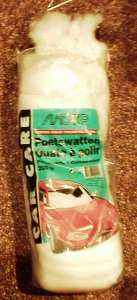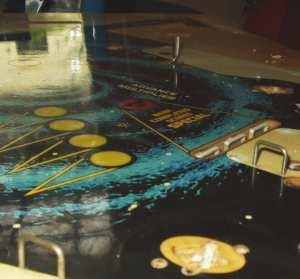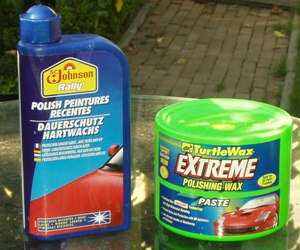The big wax war
The big wax war. Sounds important, doesn't it ? On the usenet discussion group rec.games.pinball people often refer to 'the big wax wars' or 'the big wax debate'. Everyone seems to have an own opinion about waxing and cleaning a playfield, which can result into heated debates.
The cause of these arguments is that most people have their own opinion and experiences with certain products, and don't want to know of anything else. They had good experiences with something, worse with other products, and won't believe other experiences. But not every game or playfield is the same. Different types of playfields require different products, and one may be worn more or less than another, requiring other products used on it. Even the way of using and applying a product may cause differences and good or bad results.
People also have different goals, there's a different between a collector who has a lot of time and wants to treat his playfield the best way possible, and a dealer who wants quick results: he needs a clean and shiny pinball machine so he can sell it, and doesn't care about long-term effects but only wants something which works fast without much effort.
Furthermore, there's not exactly any scientific research done to waxing and polishing playfields.. so there probably is not one right and one wrong product to use. And while some products may theoretically damage a playfield, it's applied in small quantities or the game is sold after a few years, so the owner doesn't know if something is bad in the long run.
So in this article I try to take a more objective approach, give you information and links to articles with more background information, so you can make up your own opinion. There is scientific research done to automotive products, and that can be applied to playfields.
That said, it's all relative. If you don't want your pinball machine to wear then don't play it. If you are satisfied the way you work now, don't see any (immediate) negative parts (even though there may be theoretically), that's good for you. Something you use now may not be theoretically the best, but if your game looks good and plays well, that's what matters.
I won't go much into detail about specific products, like some websites do. I'm in Europe and half of the waxes/cleaners/polishes used in the USA are not available here or sometimes even have a different consistency. And as I already said, one product may work well for one person, but less for another, because the playfield is different, the way of applying is different, .. So don't expect me to say you need Johnsons paste wax or another Carnauba-rich wax and nothing else is better. Test products and decide what you like.
I also link to some interesting articles at Autopia. I don't have any relationship with this site, I just link to them as I learned a lot from their articles and it's a good collection of information. If you search on the internet you'll find many more similar articles about polishing and waxing cars, but split up in pieces over more sites. They just have a lot of information together. Keep in mind that some sites may tell you their side of the story because they sell specific products.. so always try to confirm what you read from multiple sources.
Introduction into car waxes
The first thing you need to do is to check what type of playfield you have.
Older games (up until 1990) usually are paint which is sprayed with lacquer.
More recent games are protected by a type of automotive polyurethane clearcoat.
Williams games in the early 90ies had the Diamondplate logo on them to indicate this.
Later games (1993 and up) don't have this logo anymore but they are all clearcoated.
Some prototypes of earlier games also had clearcoated playfields (Diner, Whirlwind, ..)
so if your game is of the late 80ies, always check what type of playfield you have.
What types of product you can/should use on clearcoated and lacquered playfields are very
different !

Diamondplate logo on Addams Family playfield.

To learn more about the differences between clearcoat and lacquer and how these products evolved,
read History of Automotive Coatings.
It gives an interesting background of how everything evolved and the reasons behind it
(cost, environmental reasons, better looking, ..).
Important facts I learned from this article: using waxes goes back to the days of horse drawn carriages.
But these traditional products are not very well suited anymore for modern clearcoats !
Especially take a look at the images of scratches that waxes and cloths make !
If you polish and wax your playfields using old t-shirts, you may want to reconsider.
Clearcoat easily scratches, using the wrong type of cloth makes microscopic small scratches.
You don't notice them as you are waxing because you fill them. But when the wax wears out
the scratches are still present, and getting a super high gloss will become more and more difficult
in the future because the more you wax, the more damage you do..
Picture: the polish cotton I use now.
Just buy some good microfiber cloths to apply wax.
People who are into cars are starting to learn: Carnauba wax was a good thing in the past, but modern cars require modern products. Pinball people should also learn about and try new products on their clearcoated playfields.
Why do we wax ? When is a playfield shiny ?
Waxing a playfield is done to add a layer of protection above the clearcoat, to prevent wear.
It's also done because the game looks better: colors are more vibrant and the playfield looks
more shiny/reflective. The same reasons why people wax their cars (although you don't roll
steel pinballs over cars).
Why does a playfield become shiny ? Because it is very smooth.
This is either done by polishing the clearcoat and removing small imperfections, and by
adding wax which fills the imperfections up and puts a smooth layer on the playfield.
Also read this information about chemicals and the different products. Pay attention to the part about cleaners, polishes and waxes. You must understand the difference between them well.
- A cleaner should only remove dirt and not harm the clearcoat or give protection.
- A polish will smooth the clearcoat layer, by actually take a small layer off.
- Finally wax goes on top of the clearcoat to give it additional protection and shine.
It is best to use separate products for each of these steps, and not all-in-one solutions. With the latter you usually don't know much of each they do (how abrasive, how much protection, ..) so while they're easy to use, they can't give the optimal result (as none of them is designed for your specific playfield).
Something important to learn from this article:
Never use a polish or product that's more abrasive than required to do the job.
Paint polishes do remove fine layers of paint or clearcoat (even though some other websites
I found claim the opposite). So don't polish too much or if it isn't necessary.
Some other
common misconceptions and myths can be found here.
Important here: clearcoat needs to be waxed.
If you put a new clearcoat on a playfield,
wait 2 months before waxing.
And again: pay attention to the type of cloth you use.
Waxing clearcoated playfields
Polishing a playfield
Before you attempt to polish any playfield, please
read this article about polishing.
It explains the theory and gives a lot of information from people that have a lot of experience with it.
What I learned: don't remove too much clearcoat; things changed a lot the last 10 years; you don't need
a buffer, everything can be done by hand too but it'll take longer. And finally:
use the least aggressive tool or polishing material necessary to get the job done.

This Black Hole lower playfield is already quite smooth and reflects the light. It has only been polished
using Commandant 5 ! It has not yet been waxed.
Something else I didn't know and learned from this and other articles was about wool pads. These are aggressive cutting pads, while polishing clearcoat should only be done using foam rubber pads ?! It's not the first time I hear someone say proud they've waxed their playfield with a wool pad on their drill.. So it seems this is a very bad idea, wool will also make more scratches. And yes a polished playfield in this way will have a gloss, but results could've been much better.
Waxing your playfield

Before you start to wax your playfield,
read this article.
Synthetic waxes are more durable than Carnauba waxes, especially on clearcoat.
This is opposite of what I thought. I had always read that paste wax was better because it was more hard
then liquid wax, so I assumed (wrongly) that liquid synthetic wax was less hard then paste wax.
Show waxes however are very soft and don't offer durable protection. So while they are
nice when you want to sell a pinball machine and impress a buyer with spectacular gloss,
they don't offer good protection when the machine is being played.
The trick of using carnauba wax on top of a synthetic wax sounds good and I will try this.
First put a layer of synthetic wax, allow it to cure up to 2 days (this will give your playfield the
protection it needs against wear from pinballs), and then apply a layer of
carnauba wax over it to give extra depth in color.
Picture: the wax I use now. In the past I only used Turtle paste wax.
Now I first use Johnson synthetic wax, let it harden for a day, and then finish with
Turtle wax.
Petroleum distillates in wax products
There's one thing almost everyone in the pinball world now agrees: petroleum distillates are bad.
They make mylar and plastics dull and dissolve glue. Some people even say they damage plastic star posts.
So do not use Wildcat 125 (even though Bally recommended it in the 80ies)
or other products which contain a lot of petroleum distillates, as they will create
damage in the long run. This is for both lacquered and clearcoated playfields.
Of course, use your own judgement. Some products only contain very small traces of petroleum
distillates, you don't have to throw away every bottle that mentions them..
But when you can chose between petroleum and water-based products: take water-based.
Waxing and protecting lacquered wood
Finally, some information about lacquer can be
found here at wikipedia.
The most important thing to remember is that different types of playfields need different products.
Old-style products like carnauba wax are still best suited for your electro-mechanical pinball machine.
Modern clearcoated playfields prefer modern products.
Be very careful when working with a lacquered playfield ! It is safest not to use any polish at all,
or very very carefully because it's very easy to remove paint before you know it !
Waxing cloths

As said above already: consider what kind of cloth you use to polish and to wax.
If it's too hard or has e.g. dirt in it, it will scratch your finish.
That's the opposite you want to achieve !
If you still want to use an old t-shirt or towel:
at least wash it often so it's clean and soft again, and it doesn't have hard wax residue
in it from the last time you used it !
Picture: the polish cloth I use to wax. I use 2: one to apply wax (it usually gets a lot of
wax in it) and one to shine/remove the wax.
Conclusion
I learned a few things of the articles I linked to.
Combined products that clean and protect weren't something I used.
But I know people who only clean and never wax a playfield. Or who use a polish for regular maintenance.
As a cloth I used a lot of things, towels, an old tshirt, .. Now I only use special polish cloth.
It's not that a playfield can rust like a car can, so probably the microscopic small scratches don't matter,
but still.. you try to clean and in the meantime you make small scratches that can make a surface dull.
Synthetic wax is something I now use too. In the past I only used paste wax.
